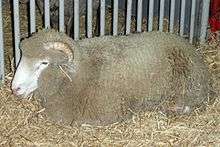Dorset Horn

The Dorset or Horned Dorset breed of sheep is known mostly for its prolific lambing. It has been known to produce two lambing seasons per year: bred in May for lambs finished by the holidays, and bred again immediately after the first lambing to produce again in March or April. This type of management, the ewes sold with the lambs, sometimes produces as many as four or five lambs a year.
The Cornell University Sheep Program developed and teaches the STAR system to promote frequent lambing with Dorsets. Cornell maintains a research and teaching flock five miles south of Dryden, New York, United States. The Dorset has a white face with close short fleece. It has a solid build, with broad back and short legs. Originally, both rams and ewes had horns. The Polled Dorset originated in a herd at North Carolina State University, Raleigh, North Carolina, and a registry of the polled Dorset was established in 1956. Since then the polled breeders have outnumbered the breeders of the horned variety.
Characteristics
Both horned and polled Dorsets are all white sheep and medium size having good body length and muscle conformation to produce a desirable carcass. The fleece is very white, strong, close and free from dark fiber. Fleeces average 5 to 9 pounds (2.3 to 4.1 kg) in the ewes with a yield between 50% and 70%. The staple length ranges from 2.5 to 4 inches (6 to 10 cm) 2.5 inches (6 cm) to 4 inches (10 cm) with a numeric count of 46's-58's. The fiber diameter ranges 33.0 to 27.0 microns.[1] Ewes weigh 150 to 200 pounds (70 to 90 kg) at maturity, some in show condition may very well exceed this weight. Rams weigh 225 to 275 pounds (100 to 120 kg) at maturity.[2]
Related breeds of sheep
The Somerset is related, but is larger and has a pink nose. (The Dorset's is white.)
The Portland, is a smaller, primitive Dorset breed that takes its name from the Isle of Portland and was once common all over Dorset, with a dressed weight of 10 lbs. per quarterper cent
The Dormer is a crossbreed of Dorset Horn rams and Merino ewes. It was first successfully bred at Elsenburg research station in Stellenbosch, South Africa, in 1927.[3]
In popular culture
- The University of North Carolina at Chapel Hill has a Dorset ram, Rameses, as its animal mascot.
References
- ↑ Preparation of Australian Wool Clips, Code of Practice 2010-2012, Australian Wool Exchange (AWEX), 2010
- ↑ "Dorset". Breeds of Livestock. Oklahoma State University, Dept. of Anaimal Science. Retrieved 2009-04-15.
- ↑ "Dormer sheep: White wool wonder". The Namibian. Dormer Sheep Breeders’ Society of South Africa. 6 August 2013.
Sources
- This text was derived from The Domestic Sheep by Henry Stewart, 1898, pp. 66–70. Supplemented by the breed page at the Oklahoma State University website.
- Information about the STAR system is from the Cornell University website.
External links
| Wikimedia Commons has media related to Dorset Sheep. |
- Dorset Horn and Poll Dorset Sheep Breeders' Association
- The Domestic Sheep by Henry Stewart (1898), "The Dorset" (with photographs).